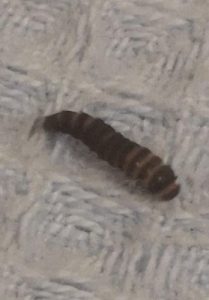
A reader in Cairo, Egypt asks for our help after discovering a worm-like creature crawling on his bed cover. The creature appears to be black and white, with a segmented, elongated body.
Our reader’s guess is that it is “a harmless carpet beetle”, but as he is not sure, he worries it may, in fact, be something harmful. He would appreciate receiving an identification, as well as some tips as to how to get rid of “any more” of these critters. First of all, we thank our reader for the excellent photos he sent in; such photos are an extraordinary help in determining the identity of these organisms. Secondly, given the creature’s physical characteristics, as well as where it was found, we can confidently say that this is indeed a carpet beetle, specifically in its larval form.
To be even more specific, this is the larva of a black carpet beetle. There are several species of carpet beetles, but this is the most destructive of them all. We have covered carpet beetles on on multiple occasions, as well as the black carpet beetle larva, so some of our avid readers are likely familiar with their basic characteristics. Carpet beetles infest homes to birth their young (larvae), which feed on animal-based materials, including clothing, bed sheets, upholstered furniture, feathers, and leather products. Now, what sets the black carpet beetle apart from other species of carpet beetle is the fact that the larvae are not as picky as their brethren; they will eat synthetic materials. This makes getting rid of them that much harder, because one cannot narrow down which garments to check for, and make free of, carpet beetle larvae.
In order to get rid of carpet beetle larvae, it takes a combination of locating a source, laundering and cleaning, and taking preventative measures to stop the attraction of carpet beetles. To locate the source, our reader will want to search for locations in his home that are dark, cramped, and seldom cleaned. For example, underneath/behind big pieces of furniture or the insides of cupboards are both reasonable places to look. This is because carpet beetle larvae prefer these sorts of environments so that they can feed in peace without worrying about being detected. One may also find carpet beetle larvae on the food source, meaning between the fibers of carpets or inside the folds of a garment, for example.
Next, laundering fabrics and cleaning one’s home persistently for one-to-two weeks is paramount when eradicating a carpet beetle infestation. Laundering fabrics at the highest temperature they can withstand will get rid of any eggs or larvae present on them, and vacuuming one’s home (especially the carpets) consistently will do the same.
Lastly, taking preventative measures to discourage more carpet beetles from infesting one’s home is key to controlling an infestation. Such measures include storing unused garments in vacuum sealed bags or cold vaults, ensuring that one’s window screens are in pristine condition, sealing cracks in walling and flooring, and laundering any thrifted clothing immediately after purchase.
To conclude, the worm-like creature our reader found crawling on his bed cover is a black carpet beetle larva. They are not harmful, but can prove to be annoying pests. We are confident that if our reader follows the methods listed above to control and ultimately eradicate this infestation, he will be free of this nuisance in no time. The best of luck to him!
All About Worms is always free, always reader-supported. Your tips via CashApp, Venmo, or Paypal are appreciated! Receipts will come from ISIPP Publishing.
You might also find these guys interesting!



















